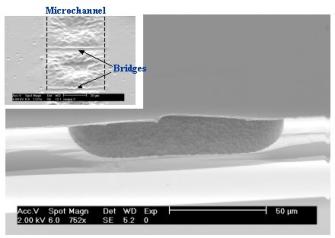
 |
|||||||
Chip-based microdialysis system |
|||||
|
George Lopez Advisor: Gary Fedder |
 |
 Cross sectional view of a suspended cellulose acetate membrane across a 75 micron wide silicon microchannel. Inset is a top view of the suspended membrane. Dotted lines are used to show the boundaries of the microchannel. Small bridges that span the microchannel are used to support the membrane; these are undercut during the etching process.  The fabrication process involves (a) using lithography to define the region where the microchannel will be created, (b) silicon etching using xenon difluoride with subsequent removal of the photoresist film using acetone, (c) spin coating cellulose acetate film onto the substrate. The sample is then immersed in deionized water to allow pore formation using the phase separation process. |
|||
|
Project: The goal of the project is to develop a point-of-care bioanalytical chip based on microdialysis principles that exploits characteristics of microelectromechanical systems technology. Currently, conventional microdialysis probes are hand assembled, have limited useable lifetime, and can't provide the necessary temporal resolution for analytical tools due to large dead volume issues. Porous cellulose acetate membranes have been suspended over 75 micron wide silicon microchannels. The microchannels are formed when a viscous polymer lacquer is directly spin cast onto etched silicon trenches (Figure 1). Semiconductor fabrication processes are used to create the channel, preventing the need for adhesives, substrate bonding, or other complex assembly procedures. Dialysis experiments are conducted to determine the molecular weight cut-off for these cellulose acetate membranes. The microchannel will be connected to a syringe pump at the inlet, providing a saline buffer and the establishment of a concentration gradient across the membrane. The microchannel outlet will be directed to a fraction collector for later analysis. A six-protein mixture consisting of myoglobin (MW=17 kDa), soybean trypsin inhibitor (20 kDa), carbonic anhydrase=29 (kDa), ovalbumin (44 kDa), bovine serum albumin (66 kDa), and human transferrin (80 kDa) is used to test the permeability of the membranes.
|
|||||
|
References: [1] Bergveld, P. , Olthuis, W., Sprenkels, A.J., Pijanowska, D., Linden, H.J. van der, Bohm, S. Integrated Analytical Systems, Comprehensive Analytical Chemistry Series, 39, pp. 625-663, 2003 [2] Mulder, M., Basic Principles of Membrane Technology, Kluwer Academic Publishers: The Netherlands, 1996 |
|||||
|
overview | projects | people | publications | intranet | resources © 1998-2009 Carnegie Mellon |